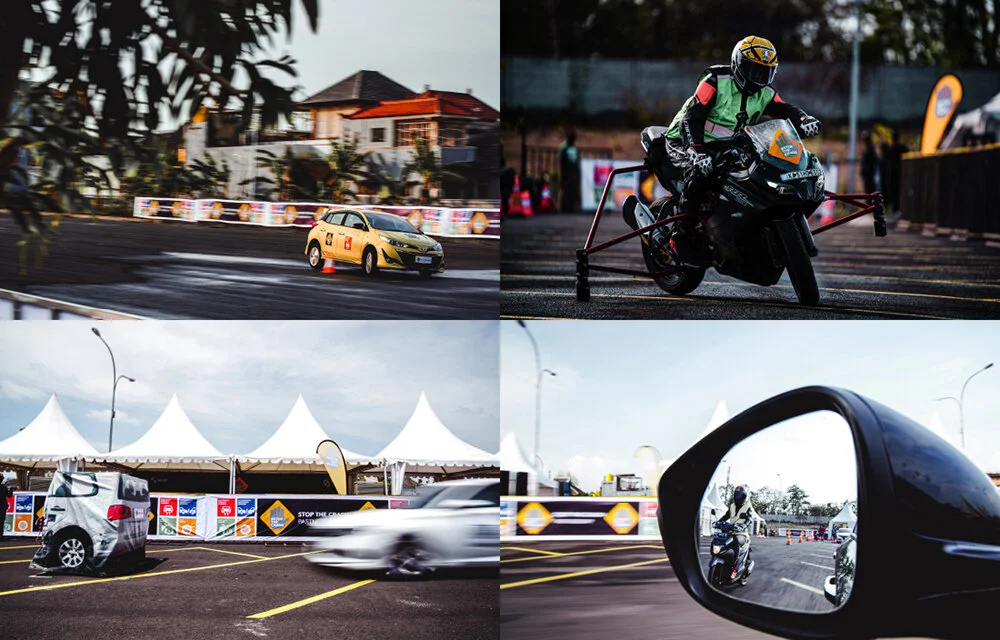#StopTheCrash Campaign For Car And Motorcycle Safety Launches In Indonesia
For the first time in Indonesia, the #StopTheCrash Partnership hosts live demonstrations of crash avoidance technologies in support of the United Nations Global Goals and the Decade of Action for Road Safety.
Launched at the Garuda Wisnu Kencana Cultural Park in Bali with the support of ASEAN NCAP and the Malaysian Institute of Road Safety Research, the #StopTheCrash Partnership event has a special focus on the life saving benefits of Electronic Stability Control (ESC), Autonomous Emergency Braking (AEB), Anti-lock Braking Systems (ABS) for motorcycles and Blind Spot Detection (BSD).
With motorcycle crashes being of major concern in the region, the event will especially highlight the importance of motorcycle ABS and blind spot detection in curbing motorcycle related trauma and encourage legislative action in making the #StopTheCrash technologies more readily available for consumers in the region.
The technologies promoted by #StopTheCrash have the potential to save thousands of lives every year and the UN has developed international standards to help encourage countries around the world to mandate these life saving technologies. Many countries have taken a lead in adopting such legislation to protect drivers, riders and other vulnerable road users. Global NCAP and the Stop the Crash Partnership encourages the Indonesian government to take a leadership role for the Asian continent in the fitment of vehicle safety technology.
David Ward, President of Global NCAP and Chairman of the Stop The Crash Partnership said:
“For the first time we’re bringing our Stop the Crash campaign to Indonesia. Hosted in partnership with ASEAN NCAP and MIROS our demonstration event will show how life saving crash avoidance technologies such as ESC and AEB work in practice. We will be putting a special focus on technologies that help protect motorcycle riders, systems like Blind Spot warnings for drivers and ABS for riders. These are especially important safety systems in Indonesia and throughout the ASEAN region, where motorcycle and moped riders are disproportionately represented in road traffic crashes.”
Khairil Anwar bin Abu Kassim, Secretary General of ASEAN NCAP said:
“The Stop the Crash launch in Bali is a collaborative effort between Global NCAP and ASEAN NCAP. This is our third event after Stop the Crash ASEAN in Kuala Lumpur (KL) in 2016 and in Bangkok in 2017. During the KL event, the Government of Malaysia announced the mandatory fitment of Electronic Stability Control in new passenger cars by June 2018. We hope this event will be a catalyst for the Indonesian Government to initiate the same outcome for vehicle safety in the Republic of Indonesia.”
Editor’s Note
Led by Global NCAP, the #STOPTHECRASH Partnership includes the ADAC, Bosch, Consumers International, Continental, Denso, ITT, Thatcham Research, Veoneer, and the Towards Zero Foundation. All are united in their shared commitment to promote advanced vehicle safety technologies in support of the UN’s Global Goals and the Decade of Action for Road Safety.
Electronic Stability Control (ESC)
ESC is the most significant advance in vehicle safety since the introduction of the seat belt and one of the most important crash avoidance systems currently available. This anti-skid technology has already helped prevent hundreds of thousands of loss of control crashes and saved tens of thousands of lives. On dry, wet, or slippery roads if the vehicle starts to skid, ESC corrects the slide by reducing engine torque and braking individual wheels to bring the vehicle back on course. The system uses sensors to continuously monitor the stability of the vehicle. When an unstable state is detected, for instance as the result of a sudden direction change, ESC responds in milliseconds and stabilises the vehicle. If the system senses oversteer (i.e. that the rear of the car is starting to drift sideways out of the turn), ESC applies the brakes to the front wheel on the outside of the turn to create a counteracting torque about the vertical axis of the vehicle. This stabilises the vehicle and turns it back onto the path intended by the driver.
Autonomous Emergency Braking (AEB)
AEB is an advanced safety technology that can help drivers avoid or mitigate collisions with other vehicles or vulnerable road users. AEB systems use forward looking radar, cameras or optical sensors or a combination of these sensors to help quickly and accurately detect impeding vehicles, pedestrians and potentially other obstacles. AEB helps provide constant monitoring of the road ahead and is designed to assist the driver by automatically applying the brakes if they do not respond in an imminent crash situation. AEB currently exists in three formats: City, Inter Urban and Pedestrian.
Anti-Lock Brakes in Motorcycles (ABS)
ABS for motorcycles prevents wheel lock-up and ensures bike stability as well as optimal deceleration while braking. ABS therefore significantly reduces the risk of falling and reduces stopping distance. On a motorcycle fitted with an antilock braking system, the ABS control unit constantly monitors the speed of the wheels using wheel-speed sensors. If a wheel threatens to lock during hard braking or on slippery roads, the antilock braking system regulates the braking pressure in a targeted manner, thereby ensuring optimum braking. In this way, the driving stability and maneuverability of the motorcycle is maintained, even where there are adverse driving conditions such as sand, loose chippings or water. This significantly reduces the risk of a brake-induced fall, and usually shortens the braking distance. Depending on the model, the motorcyclists can recognize that the ABS has kicked in through a gentle pulsing on the hand and foot brake levers.
Blind Spot Detection (BSD)
BSD is a system that monitors the adjacent lanes and assist drivers during lane changes. If there are other vehicles present in the vehicle’s blind spot zone, especially smaller vehicles such as motorcycles and bicycles, drivers will be alerted to their presence either through a visual or audio-visual warning.





